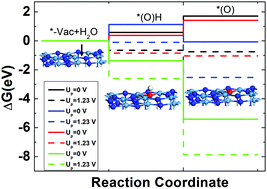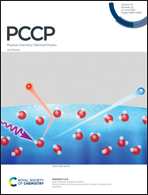Theoretical insight into the anion vacancy healing process during the oxygen evolution reaction on TaON and Ta3N5
Abstract
Anion vacancies are common defects in materials, and they are usually much more stable on the outermost surface. These vacancies are sometimes taken as active sites in some reactions during catalysis. During the oxygen evolution reaction (OER), these vacancies may be healed by oxygen atoms from water. But this healing process is not well understood yet. In this work, we investigated the details of the anion vacancy healing process in the OER using TaON and Ta3N5 as models. In the OER process, we found that the vacancies are stable and cannot be healed without an applied potential. But with the equilibrium potential of 1.23 V, the vacancies on the outermost top surface will be healed. The oxygen vacancies, after healing, revert back to a clean surface. The nitrogen vacancies become an oxygen doped surface after vacancy healing. We also investigated the vacancy healing process on other well-known photocatalysts, like TiO2, BiVO4, WO3, α-Fe2O3, NaTaO3 and SrTiO3, and we found that the vacancies on the top surface of these materials will also be healed in the OER with an applied equilibrium potential of 1.23 V. The results presented here could expand to other materials used for the OER in (photo) electro-catalysis and photocatalysis. This work provides a new insight for understanding the role of vacancies in the OER.



 Please wait while we load your content...
Please wait while we load your content...